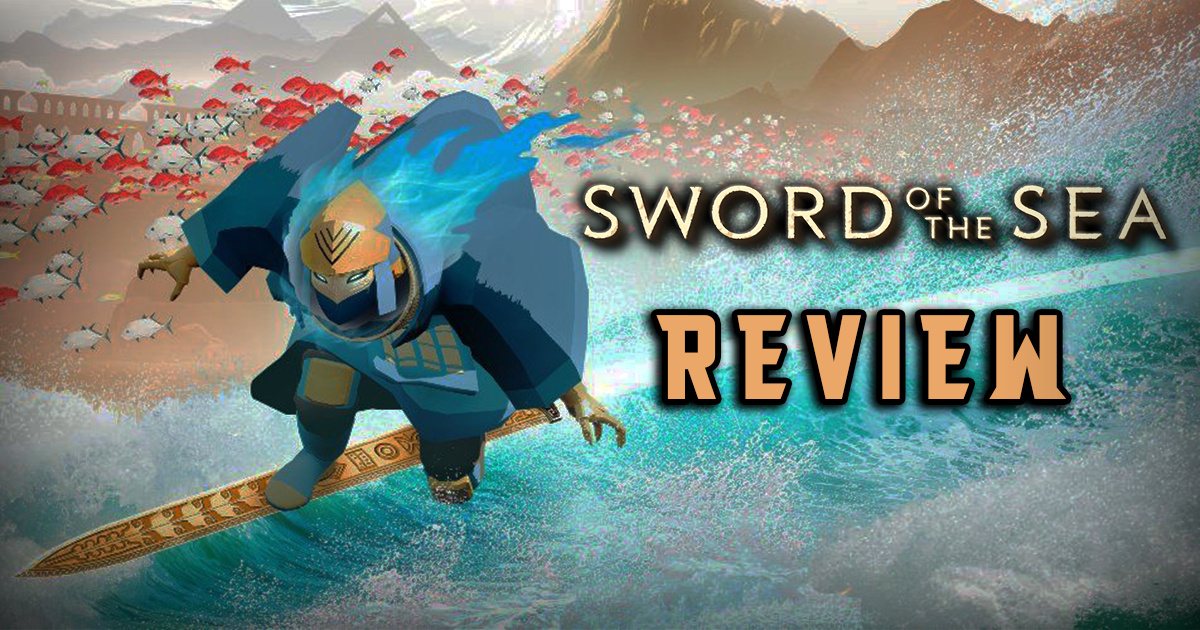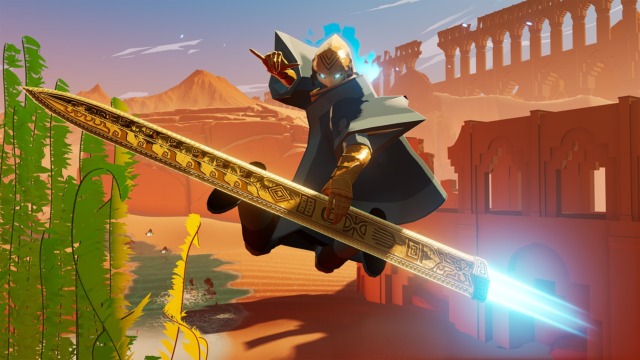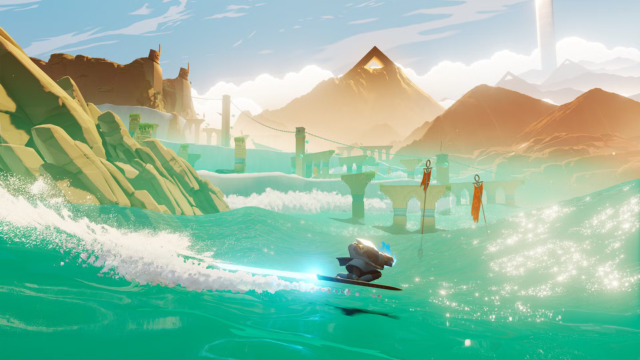Game Review: ‘Sword of the Sea’ from Giant Squid Studios

There’s a particular feeling that only a certain genre of games can give you. It’s the feeling that the only thing you have to care about is the story of the game and nothing else. Sword of the Sea is another game from Giant Squid, directed by Matt Nava, that takes that feeling, creates an experience around it, and provides you with a beautiful, breathtaking game.
The studio’s past games, like Abzû or The Pathless, were previously received very positively by players and reviewers. Sword of the Sea, from the beginning, has the same confidence and boldness that those games had. It is solemnly focused on the experience and emotional journey through the story with the quiet pleasure of exploring a living landscape that creates an unusual world around you.
Sword of the Sea: the story and ambiance of the journey
Sword of the Sea opens by introducing us to the character Wraith, who is resurrected into a world that looks like a desert but behaves like an ocean. There’s no long setup over a few chapters, no rules, no speeches, and no big explosions. Your task is to bring that desert sea back to life.
Each region that you arrive at is unique, and the land there is rough, dense, and quiet. As you travel through the desert and restore ancient mechanisms, the narrative focuses on you experiencing and focusing on the environment rather than the verbal narrative.
Whenever you restore an area, there is a short, wordless celebration with elegant music, and that’s it. By the final act, when controlling Wraith’s movement feels like second nature and the land is awake, you understand that what you experienced in that game is more about new beginnings than bringing back memories.
It’s a story fully told through touch, experience, and gliding through areas, and it works. Mainly because of the decision to revive these places and prove to you that everything you did was not a mistake.

Each part of Austin Wintory’s score makes sure that you feel invited to this world and to this journey. There are no lyrics, just ambient sounds of sand and nature around you, all hushed and patient, changing its tempo whenever you progress through the story. The overall result is really good, because the whole narrative that you experience becomes even more important. Experiencing this game’s story is more about mashing various buttons in random orders. It’s about using your eyes and ears to find out the real beauty of this world and that there are games that don’t require a lot of gameplay to make a statement.
Gameplay in this Giant Squid Studios game
At its core, Sword of the Sea is about experiencing everything that happens around you. Your sword is serving as a hoverboard, a blade, and a tuning fork for restoring the world. When traveling, it feels like a hybrid of skateboarding and snowboarding, but with more leeway towards surfing. You hold a low stance to build speed, pop the nose for air, angle your landings, and just glide throughout the land.
The game’s smartest trick is that it rarely asks you to generate speed from nothing. Instead, the terrain is alive and creates spines, ramps, and ripples that create a natural way for you to get speed. Levels are built like oversized skateparks filled with ruins and routes that will get you wherever you have to go.
Sword of the Sea is relatively easy when it comes to puzzles. Most gates open when you’ve connected a zone by hitting a few ritual points, drawing a glowing line through statues, or creating a sound with enough breaks between.
There’s a recurring moment of “activate structures to awake the area,” which sounded to me like a repetition in the beginning, but the way you have to complete those tasks changes with the environment. One region might ask you to wall-ride through narrow canyons and connect the beginning and the end, and another might turn the sea into a dense material that launches you up, and you must glide on a ramp of some sort.
The Wraith doesn’t use the sword to fight in a traditional sense. Your blade isn’t a weapon, more like a tool. What surprised me most is how the game lets you experience everything that’s going on. You can spin, flip, and sketch little improvisations into your gliding line, but you’re never forced into making combo hits or anything like that. If you want to push yourself, there’s a lot of space in the physics of the game to do so. But any failure is short, and recovery is instant. The gameplay and the world are generous enough with the players not to make us angry with the game.

Structure-wise, Sword of the Sea is a game about the lack of complicated mechanics and is full of emotional moments of making life come back to the desert. Whenever you reawaken the zone, they remain there like playgrounds, so you can explore them. It’s the kind of postgame that makes sense for a movement-first experience, where you may want to just chill for a while before you turn off the game.
One thing I appreciated is how the art direction uses restraint to present us with a huge scale of this world. Unlike games that are trying to be as photorealistic as they can, Sword of the Sea is happy to be just a beautiful and moving living painting.
Sand breaks into wide strokes, ruins are covered with simple weathered lines, and each detail is well-thought-out. The clarity helps a lot sometimes. The soundtrack really helps during transitions and traveling, as it helps you relieve a lot of stress.
Final thoughts on Sword of the Sea
Sword of the Sea is the rare example of a modern game that promises to be precisely what it is. There is no cutting the content during the game or adding something unexpected. When you think about it, it’s like a movement poem that helps you to spend around four hours learning about this world that is alive underneath you. It’s a short game, but it’s fulfilling in a way that doesn’t require you to spend many hours on upgrading, discovering, and collecting things just to progress further.
If you love games with sophisticated puzzle elements, short campaigns, or deep stories that have more than one meaning, this is the game for you. Mostly, Sword of the Sea feels like some sort of manifesto that gives you a lot to think about after you finish the game.
The game itself is beautiful, calm, and ambient. The places you restore are points of your journey that are meaningful and worth remembering. There’s something beautiful about that idea that some games are so simple, done with a lot of heart, and they give you what they want, for how long they want, and in the way they want.
My rating for this game: 4.5/5
Sword of the Sea is one of those games that drops an unexpected trailer during one of the gaming panels; you notice them, get a little hyped, and play when they come out. Almost every single time, they are worth it. Giant Squid has proven they are a studio that knows what they want and has games created with purpose.
Also check out: Game Review: Abyssus is an Unforgettable Brinepunk Roguelike


